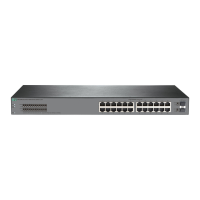142
duplicate addresses. Each IPv6 unicast or anycast address has a corresponding solicited-node
address. The format of a solicited-node multicast address is FF02:0:0:0:0:1:FFXX:XXXX.
FF02:0:0:0:0:1:FF is fixed and consists of 104 bits, and XX:XXXX is the last 24 bits of an IPv6
unicast address or anycast address.
EUI-64 address-based interface identifiers
An interface identifier is 64 bits long and uniquely identifies an interface on a link.
On an IEEE 802 interface (such as a VLAN interface), the interface identifier is derived from the
link-layer address (typically a MAC address) of the interface. The MAC address is 48 bits long.
To obtain an EUI-64 address-based interface identifier, follow these steps:
1. Insert the 16-bit binary number 1111111111111110 (hexadecimal value of FFFE) behind the
24th high-order bit of the MAC address.
2. Invert the universal/local (U/L) bit (the seventh high-order bit). This operation makes the
interface identifier have the same local or global significance as the MAC address.
Figure 54 Converting a MAC address into an EUI-64 address-based interface identifier
IPv6 path MTU discovery
The links that a packet passes from a source to a destination can have different MTUs, among which
the minimum MTU is the path MTU. If a packet exceeds the path MTU, the source end fragments the
packet to reduce the processing pressure on intermediate devices and to use network resources
effectively.
A source end uses path MTU discovery to find the path MTU to a destination, as shown in Figure 55.
1. The so
urce host sends a packet no larger than its MTU to the destination host.
2. If the MTU of an intermediate device's output interface is smaller than the packet, the device
performs the following operations:
{ Discards the packet.
{ Returns an ICMPv6 error message containing the interface MTU to the source host.
3. Upon receiving the ICMPv6 error message, the source host performs the following operations:
{ Uses the returned MTU to limit the packet size.
{ Performs fragmentation.
{ Sends the fragments to the destination host.
4. Step 2 and step 3 are repeated until the destination host receives the packet. In this way, the
source host finds the minimum MTU of all links in the path to the destination host.

